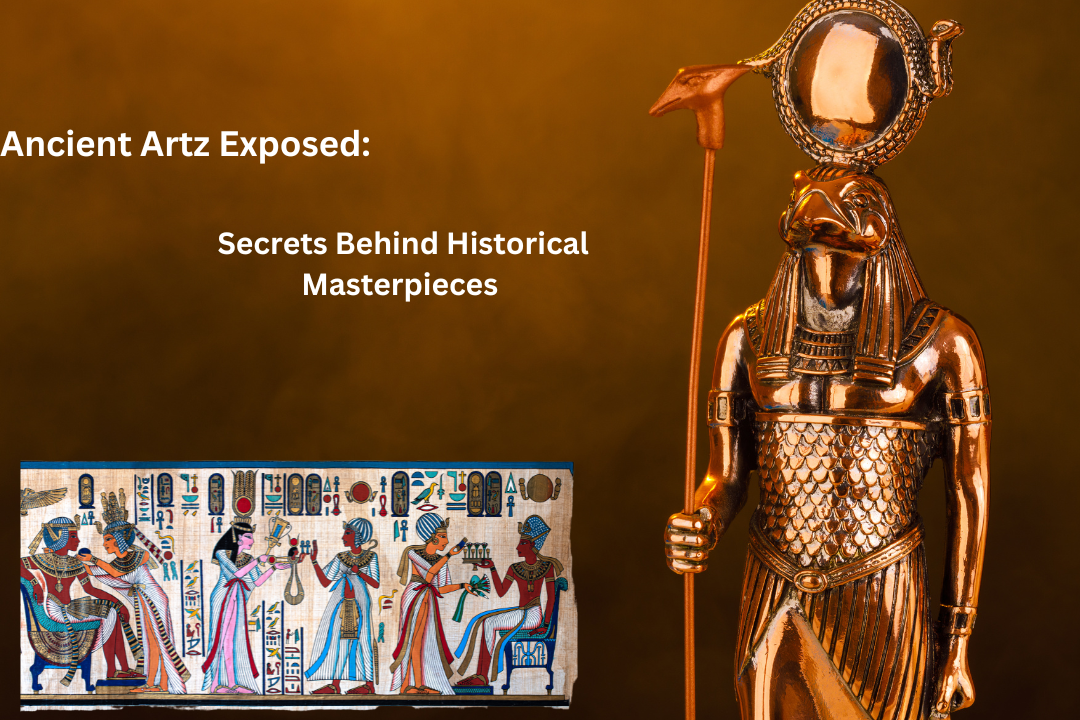Unveiling the Mysteries: What Makes Ancient Artz Fascinating?
From the touchy brushstrokes of Chinese landscapes to the complex carvings of Egyptian hieroglyphs, ancient artz has continuously held a particular area in our creativity. But what about the historical masterpieces that captivate artwork fanatics, records buffs, and educators alike? This blog submits pursuits to peel back the layers of time and discover the secrets and techniques that make ancient artz captivating. We’ll explore its origins, methods, cultural importance, and much more, comprehensively studying this timeless challenge.
Origins of Greatness: The Birth of Ancient Artz
Historic artwork’s roots stretch back many years, beginning with the earliest human civilizations. From the cave artwork of Lascaux to the pottery of the Jomon length in Japan, these early expressions of creativity laid the groundwork for future creative endeavours.
The Dawn of Artistic Expression
Human beings have always had an innate preference to express themselves, glaring in the earliest cave artwork determined in locations like Lascaux, France. These primitive but effective works capture the essence of existence millennia ago, illustrating hunts, animals, and everyday activities.
Cultural Milestones
Ancient Egypt, Mesopotamia, and the Indus Valley Civilization contributed precise styles and strategies. For instance, Egyptian artwork frequently centres on the afterlife and deities, even though Mesopotamian artwork is known for its ziggurats and cuneiform script.
The Jomon Pottery
In Japan, the Jomon period produced some of the earliest acknowledged pottery, characterized by intricate designs and patterns. This period marked a significant shift in the way humans created and preferred art.
Symbolism and Technique: Decoding Ancient Artistic Methods
Every masterpiece from historic times contains layers of symbolism and employs unique strategies that make it precise. Decoding these elements can offer us a more profound knowledge of the cultures that produced them.
Symbolism in Egyptian Art
Egyptian artwork is rich in symbols, from the ankh representing existence to the scarab symbolizing rebirth. Understanding those symbols can provide insights into the Egyptian worldview and beliefs about life and death.
Greek Techniques
The Greeks pioneered perspective and anatomy in their sculptures and artwork. Their strategies inspired Western art and influenced limitless generations.
Chinese Brushwork
The fragile brushwork in Chinese scenes gives a window into the methods of reasoning and style of verifiable China. The utilization of ink and wash procedures catches nature’s magnificence in a way that is both simple and significant.
Iconic Masterpieces: A Closer Look at Key Ancient Artz Works
Specific works have endured for the long haul, transforming into notorious portrayals in their particular societies. We should take a more top-to-bottom view of some of those show-stoppers and the stories they illuminate.
The Incomparable Sphinx of Giza
One of the most fantastic pix of antique Egypt, the Remarkable Sphinx of Giza, remains a statement of the planning and innovative restriction of the old Egyptians. Its perplexing grin keeps the antiquarians and voyagers interested in the same.
The Parthenon Marbles
These marble sculptures from historical Greece showcase the height of Greek artistry. The precise carvings depict various scenes from mythology and everyday life, offering a glimpse into the tradition of ancient Athens.
The Terracotta Army
Found in 1974, the Terracotta Armed Force is a gathering of many ways of life measured by dirt infantrymen covered with China’s most memorable ruler, Qin Shi Huang. Each parent is novel, displaying the top-notch capacity of old Chinese skilled workers.
Materials and Methods: How Ancient Artz Was Created
The materials and techniques used in historical art are as numerous because of the cultures that produced them. Understanding those factors can give us a deeper appreciation of ability and creativity.
Stone and Marble
Stone and marble were often used in sculptures and homes, especially in ancient Greece and Rome. The sturdiness of these materials has allowed many works to continue to exist today.
Earthenware and Pottery
Pottery has become a common medium in many historical cultures, from the Jomon length in Japan to the Greek and Roman eras. The techniques used in pottery creation provide insights into these civilizations’ daily lives and rituals.
Paint and Pigments
Everyday shades had been utilized to make brilliant artworks and wall paintings. In old Egypt, for instance, minerals like malachite and lapis lazuli were overpowered to make lively veggies and blues.
Cultural Significance: The Role of Art in Early Societies
Art was essential to ancient civilizations’ cultural and social fabric. It became a form of expression, a method of communication, and a document.
Religious Significance
In many cultures, art became closely tied to faith. Temples, tombs, and spiritual artefacts regularly featured elaborate designs intended to honour deities and the dead.
Social Status
Art became a marker of social repute. In ancient Rome, for example, owning a villa embellished with frescoes became a signal of wealth and prestige.
Educational Tool
Art served as an educational tool, passing down stories, myths, and ancient activities from one generation to the next. It helped to preserve a civilization’s collective reminiscences.
Lost and Found: Discoveries That Changed Our Understanding of Ancient Artz
Over the years, numerous discoveries have shed new light on historic art, challenging our previous knowledge and opening up new avenues of study.
The Rosetta Stone
Found in 1799, the Rosetta Stone became the key to deciphering Egyptian symbolic representations. This leap forward permitted history students to peruse and perceive boundless, verifiable texts.
The Dead Sea Scrolls
Found during the 20th 100 years, the Dead Ocean Parchments are a gathering of Jewish texts that gave precious experiences into the otherworldly and social acts of old Judaism.
The Terracotta Army
The disclosure of the Terracotta Armed Force, now not handiest, found the glory of memorable China’s funerary practices anyway also featured the excellent craftsmanship of its craftsmen.
The Influence of Ancient Artz: How It Shaped Modern Creativity
The effect of ancient artz continues to be felt nowadays, influencing everything from modern-day art to modern architecture.
Artistic Techniques
Many current artists draw from historical strategies, incorporating angles, symbolism, and anatomical accuracy.
Architectural Styles
Ancient architectural styles, including Greek columns and Roman arches, were retained to encourage the design of modern homes and public areas.
Cultural References
Ancient myths and testimonies often find their way into modern literature, movies, and other media, showcasing the iconic legacy of historical art.
Preserving the Past: Efforts to Maintain Ancient Artz
Preserving historic artwork is critical for ensuring that destiny generations can continue to research from and admire these priceless treasures.
Restoration Projects
Many businesses are dedicated to restoring historic works of art, using advanced strategies to repair and keep them for posterity.
Digital Archiving
Digital archiving efforts, including 3D scanning and virtual truth, are helping to preserve ancient artz in a format that can be easily accessed and studied.
Education and Awareness
Educational programs and public exhibitions are vital in raising awareness about preserving historical art and encouraging public support for these efforts.
Future Insights: What We Can Learn from Ancient Artz Today
While historical art provides a window into the beyond, it also offers valuable training for the present and future.
Sustainability
Many historic cultures practised sustainable artwork-making methods, such as using herbal materials and minimizing waste. These practices offer precious insights into current efforts to create more sustainable art.
Cultural Exchange
Ancient artz regularly displays a mix of impacts from unique cultures, highlighting the importance of cultural exchange and collaboration.
Innovation
The creativity and ingenuity of historical artists inspire innovation in diverse fields, from art and layout to generation and engineering.
FAQs
What is the oldest acknowledged piece of art?
The most established perceived piece of fine art is the not set in stone in Chauvet Cavern, France, which dates back to roughly 30,000 BCE.
How had historical pigments been made?
Antiquated colours have been created from surely going on minerals and natural substances, alongside plant concentrates and creature bones.
What is the importance of the Rosetta Stone?
The Rosetta Stone became essential in disentangling Egyptian pictographs, allowing history experts to figure out fundamental Egyptian messages.
How long did it take to create the Incomparable Sphinx of Giza?
Improving the Exceptional Sphinx of Giza required about three years of work through countless workers.
What materials had been used inside the Terracotta Army?
The Terracotta Army was crafted from clay, with every figure being moulded, fired, and painted to create life-sized soldiers.
Are there any historical artwork forms that are still practised today?
Many ancient artz forms, such as pottery, weaving, and calligraphy, remain practised and appreciated today.
How do current artists draw concepts from historic art?
Modern artists frequently contain ancient techniques, patterns, and symbolism in their paintings, creating a communication between the beyond and the present.
What position did artwork play in historical societies?
Art played a vital role in historical societies, serving religious, social, and academic functions.
How are ancient works of art preserved nowadays?
Ancient artistic endeavours are preserved through recuperation initiatives, digital archiving, and academic applications that raise awareness of their significance.
What are we able to examine from ancient artz today?
Ancient artz offers treasured training in sustainability, cultural change, and innovation, supplying insights that are applicable to contemporary society.
Conclusion
Ancient artz continues to captivate and encourage us, illuminating early civilizations’ lives, ideals, and creativity. By expertise in these masterpieces’ origins, techniques, and cultural significance, we will gain a deeper appreciation for the art that has fashioned our world. Whether you are an art enthusiast, history buff, or educator, there’s continually extra to find out and research from the rich tapestry of historic artwork. In addition, explore this fascinating concern, recall touring museums, attending lectures, or reading books on ancient artz. The more we learn, the more we appreciate those historic masterpieces’ enduring legacy.

